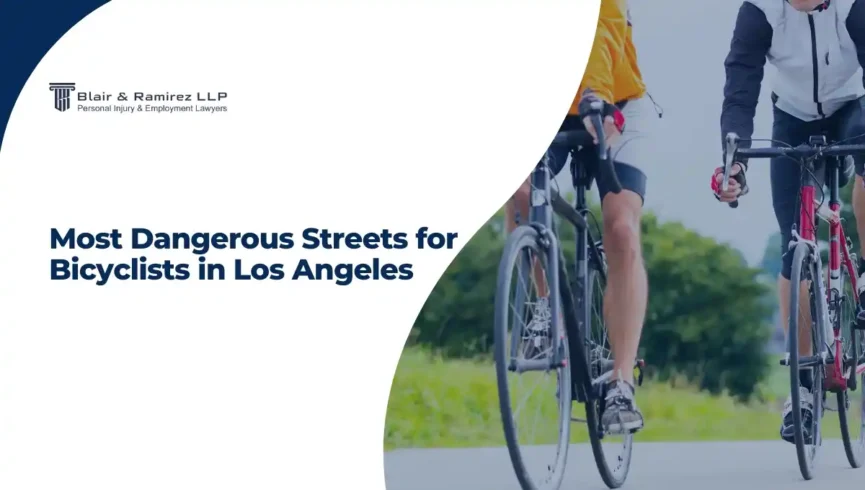In 2023, 32 bicyclists lost their lives on Los Angeles County streets, many on roads without bike lanes. With its wide, high-speed corridors and patchy bike infrastructure, LA can be a dangerous place to ride. The city’s layout often prioritizes cars, leaving cyclists exposed at busy intersections and along major thoroughfares. This article breaks down the most hazardous streets and intersections for bicyclists in Los Angeles, explores the root causes behind these dangers, reviews existing laws, and offers real solutions to improve safety. Whether you are a cyclist, commuter, or someone affected by a crash, you will find actionable takeaways, and if you have been injured, it may be time to speak with a legal professional who understands what you are up against.
Top 4 Collision Prone Intersections for Bicyclists in Los Angeles
Bicycle crash hotspots in Los Angeles are often found where dense traffic, poor visibility, and inadequate infrastructure collide, literally. These chaotic intersections pose serious risks for even the most experienced cyclists. Below, we spotlight four of the most dangerous and high-risk roads for bicyclists in the city, where collisions are far too common and urgent improvements are needed.
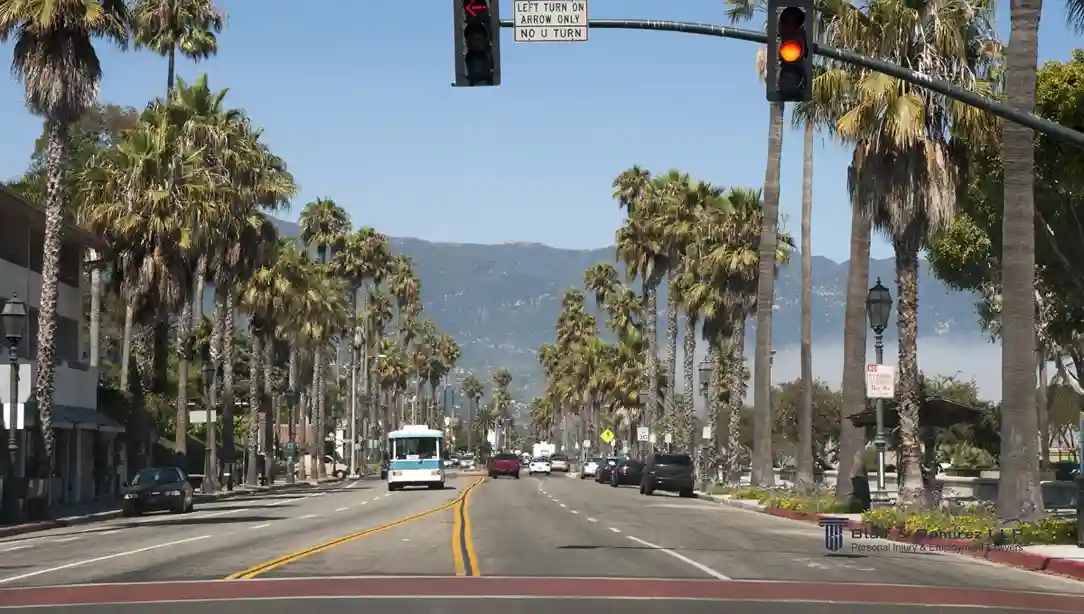
Olive Street & W 7th Street – High Congestion and Limited Visibility
West 7th Street is a constant flurry of cars, buses, delivery vans, and pedestrians. The area’s narrow shoulders and multiple lane crossings leave little room for bicyclists to navigate safely. With constant movement in all directions, this urban hub is especially unforgiving during rush hour.
Parked vehicles and rideshare pickups often block the view of oncoming traffic, creating dangerous blind spots for cyclists. Rear-end collisions and side-swipes are common here, making it a prime example of a bicycle crash hotspot in Los Angeles where high congestion and limited visibility combine into a risky mix.
Hill Street & W 5th Street – Narrow Lanes and Heavy Foot Traffic
At Hill Street and West 5th Street, cyclists face a perfect storm of narrow lanes, dense pedestrian traffic, and constant rideshare drop-offs. Situated near civic centers and public transit stops, the sidewalks are often overflowing, while the limited space on the road leaves bikes wedged between buses and fast-moving vehicles. With no protected left-turn signals, drivers frequently cut off cyclists mid-turn, creating a high-risk environment where collisions are all too common. This intersection stands out as a major bicycle crash hotspot in Los Angeles, demanding immediate safety improvements.
Wall Street & E 4th Street – Industrial Vehicle Traffic and Tight Corners
Tucked into the industrial edge of Downtown LA, the intersection of Wall Street and East 4th Street is a dangerous mix of freight traffic, tight corners, and poorly marked lanes. Cyclists here must navigate around large commercial trucks with wide turning radii and significant blind spots, often without the protection of dedicated bike lanes or clear road markings.
The limited visibility at turns and lack of infrastructure make it difficult for drivers to see cyclists in time, especially in low-light or high-traffic conditions. As a result, this intersection has become a serious bicycle crash hotspot in Los Angeles, where industrial operations meet fragile commuter routes with little room for error.
Los Angeles Street & W 7th Street – No Bike Signals and Cramped Sidewalks
At Los Angeles Street and West 7th Street, cyclists face confusing traffic patterns without the guidance of dedicated bike signals. Cramped sidewalks often force riders into the street, where they must navigate alongside impatient drivers and unpredictable vehicle movements. The lack of infrastructure maintenance and inconsistent signage only adds to the confusion, turning this busy downtown junction into another serious bicycle crash hotspot in Los Angeles.
High-Collision Corridors That Demand Urgent Attention
Unlike isolated intersections, certain corridors in Los Angeles pose a constant threat to bicyclists due to heavy, fast-moving traffic, poor bike-safe design, and unpredictable driver behavior. These stretches of road see repeated collisions year after year, highlighting systemic infrastructure issues. Below, we identify key high-collision corridors where urgent improvements are critical for cyclist safety.
Washington Boulevard (Figueroa to Main) – Speeding and Inconsistent Lane Markings
Washington Boulevard between Figueroa and Main functions as a high-speed east-west connector, but its inconsistent lane markings and lack of clear separation between vehicles and bikes make it especially dangerous for cyclists. Without designated turn-only lanes, drivers often make sudden, unpredictable movements that put riders at serious risk.
The corridor has seen numerous crashes involving side-swipes and missed stops, a pattern that reflects both poor design and high traffic volume. As a key bicycle crash hotspot in Los Angeles, this stretch urgently needs clearer lane definitions and traffic-calming measures.
Hollywood Blvd & Highland Avenue – Tourist Density and Aggressive Turns
Hollywood Boulevard and Highland Avenue is a bustling intersection where dense pedestrian traffic, tour buses, and frequent U-turns create a hazardous environment for cyclists. With sidewalks often overcrowded with tourists, cyclists are frequently forced into mixed-traffic lanes, increasing the risk of collisions. The lack of dedicated bike lanes and the unpredictable behavior of drivers, including sudden stops and aggressive turns, further exacerbate the danger. This area has seen a high rate of cyclist injuries, particularly during peak tourism months, highlighting the urgent need for improved infrastructure and safety measures.
Sunset Blvd & Vine Street – Rush Hour Gridlock and Distracted Drivers
Sunset Boulevard and Vine Street is a notoriously congested intersection, especially during rush hours, with drivers often distracted by cellphones. The traffic flow here varies dramatically between day and night, frustrating drivers and leading to unpredictable, aggressive maneuvers. Cyclists, lacking protected bike lanes, are left vulnerable in stop-and-go traffic, squeezed between vehicles with little escape from the chaos. This intersection remains a high-risk zone for collisions, where the combination of congestion, distraction, and erratic driving creates serious dangers for bicyclists.
Figueroa Street & Exposition Boulevard – Shared Bus Lanes and Stadium Crowds
At Figueroa Street and Exposition Boulevard, cyclists share lanes with buses, creating a hazardous environment, especially on game and event days. The high foot traffic and crowds around the stadium make navigation even more difficult, with sudden lane shifts and blocked visibility at crosswalks. During night events, when visibility is lower and traffic is heavier, the risk of cyclist crashes increases significantly, making this intersection one of the most dangerous for bicyclists in the area.
Santa Monica Blvd & Sepulveda Blvd – Mixed-Use Lanes and Low Lighting
Santa Monica Boulevard and Sepulveda Boulevard feature poorly lit intersections and bike lanes that are often indistinguishable from car lanes, increasing the risk of accidents. With competing priorities from cars, buses, cyclists, and pedestrians, the area becomes chaotic, particularly during peak hours. After dark, visibility issues amplify the dangers, making cyclists more vulnerable to crashes as drivers struggle to see them in the low lighting. This intersection stands out as a critical area for improving bike lane visibility and overall safety.
What Makes These Streets Risky for Cyclists in Los Angeles?
These aren’t just bad roads, they follow patterns. Here’s why crashes keep happening in the same places: poor infrastructure, high traffic congestion, and unpredictable driver behavior create dangerous conditions for cyclists. From shared lanes with buses on Figueroa to confusing intersections like Hollywood Blvd and Highland Avenue, the lack of dedicated bike lanes, inconsistent road markings, and crowded environments leave cyclists vulnerable to frequent accidents.
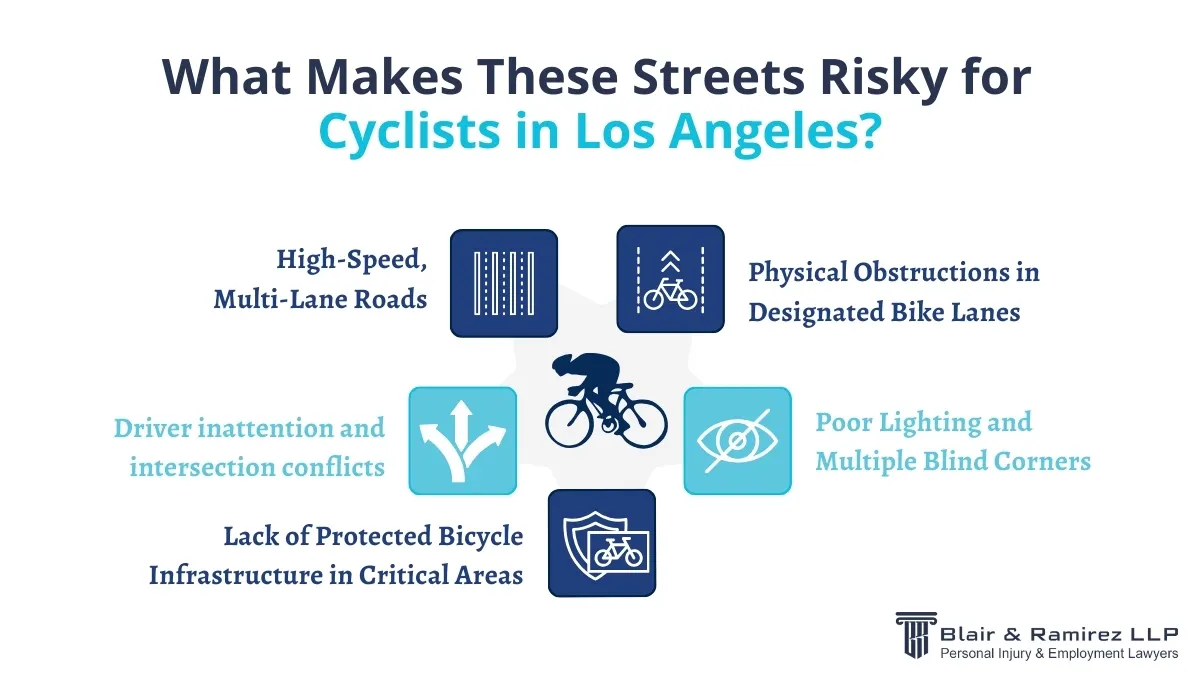
High-Speed, Multi-Lane Roads
On high-speed, multi-lane roads, drivers tend to behave more aggressively, especially when the road spans three or more lanes. Wide roads often encourage speeding, with little regard for cyclists sharing the space. At higher speeds, drivers' awareness of their surroundings significantly drops, and lane changes occur quickly, often without considering cyclists in adjacent lanes. The combination of speed and reduced reaction time leaves little room for error, making these roads particularly dangerous for bicyclists in the event of an emergency or sudden stop.
Driver inattention and intersection conflicts
Driver inattention plays a major role in explaining bicycle accident stats in LA. According to data from the Los Angeles Department of Transportation (LADOT), a significant percentage of collisions involving cyclists are linked to distracted or inattentive driving. Whether due to mobile phone use, in-car technology, or simply failing to scan for cyclists, inattentive driving creates high-risk conditions, especially at intersections.
Intersections are particularly dangerous zones for cyclists because they are where most conflicts between bikes and turning vehicles occur. Two common crash patterns are the left-hook and right-hook collisions. A left-hook occurs when a vehicle traveling in the opposite direction turns left across the path of an oncoming cyclist. A right-hook happens when a vehicle turning right fails to yield to a cyclist continuing straight in the bike lane.
These types of crashes are often the result of drivers not seeing cyclists or underestimating their speed. In a city as large and fast-paced as Los Angeles, even a momentary lapse in attention can lead to severe or even fatal outcomes.
Improving visibility at intersections, educating drivers on safer driving techniques, and enforcing distracted driving laws more strictly are essential steps in reducing these types of accidents.
Lack of Protected Bicycle Infrastructure in Critical Areas
A key factor behind the high number of cyclist injuries in Los Angeles is the lack of protected bicycle infrastructure in critical areas. While some neighborhoods have seen improvements, many of LA’s most trafficked routes either lack bike lanes altogether or feature lanes that offer no real protection from vehicle traffic.
In several parts of the city, protected bike lanes abruptly end, forcing cyclists to merge into fast-moving traffic with little warning. Areas like Venice Boulevard, Sunset Boulevard, and portions of Figueroa Street have sections where protective barriers disappear or shift cyclists into shared lanes, increasing the risk of collisions.
Physical buffers, such as concrete barriers, raised curbs, or even simple bollards, save lives by clearly separating cyclists from motor vehicles. Without these safety features, cyclists are more exposed to sudden door openings, sideswipes, and unsafe passing by drivers. Studies have consistently shown that protected bike lanes significantly reduce crash rates, especially in urban environments with high vehicle volumes.
Poor Lighting and Multiple Blind Corners
Poor lighting and multiple blind corners contribute significantly to the high number of cyclist crashes in Los Angeles. Visibility is a critical factor when it comes to avoiding accidents, and a lack of proper lighting can drastically increase the likelihood of a collision, particularly in low-traffic areas or during nighttime riding.
When cyclists are navigating poorly lit streets, drivers have less time to notice them, and cyclists themselves may struggle to spot hazards in their path. In fact, studies have shown that crashes are far more likely to occur in areas with insufficient lighting, with nighttime cycling accidents being a major concern. Without proper illumination, cyclists are forced to rely on streetlights or car headlights, which often fail to provide adequate visibility, especially in areas with dim or broken lighting infrastructure.
Neighborhoods such as South LA, Echo Park, and West Adams are known to suffer from inconsistent or inadequate street lighting. In these areas, cyclists face heightened danger as they approach blind corners, intersections, or areas with poor roadway maintenance. The combination of poor visibility and the unpredictability of blind spots makes these areas particularly risky.
Physical Obstructions in Designated Bike Lanes
One of the most common street design problems for cyclists in Los Angeles is the presence of physical obstructions in designated bike lanes. Despite efforts to create more bike-friendly infrastructure, bike lanes are often blocked by everyday objects and temporary barriers, making it difficult and at times dangerous for cyclists to navigate.
Examples of these obstructions include trash bins left in the bike lane, delivery vehicles parked in cycling paths, and construction barriers that force cyclists into car lanes. These obstacles create unnecessary hazards, forcing riders to swerve into traffic or come to a sudden stop, increasing the likelihood of collisions with vehicles.
For instance, downtown Los Angeles and areas around Venice Beach are notorious for delivery trucks and service vehicles blocking bike lanes during peak hours. This is a serious issue, particularly for cyclists who rely on these lanes for safe travel in high-traffic areas. Furthermore, construction zones often place temporary barriers that limit the width of bike lanes, making it challenging for riders to pass through safely.
What LA Laws Protect Bicyclists on High-Risk Roads?
Knowing your rights isn’t just smart, it’s how you protect yourself if something goes wrong. In Los Angeles, several laws are designed to safeguard cyclists, but understanding them is crucial for ensuring your safety on high-risk roads. These rules help define cyclists' rights on the road, the obligations of drivers, and the responsibilities for safe passing, lane changes, and turns. Below, we dive into the key California bicycle legal rules and regulations that can help protect you when riding through these dangerous streets.
Same Rights as Drivers – Equal Rights and Road Duties
Cyclists have the same rights and responsibilities as motor vehicles on the road. According to California Vehicle Code §21200-21212, cyclists are required to obey traffic signs, signals, and laws just like any other driver. This means cyclists must follow speed limits, stop at red lights, and yield when required. However, cyclists are also legally protected and should be treated with the same respect as any motor vehicle on the road. This equal treatment ensures that cyclists have the right to ride safely and be protected under the law if they are involved in an accident.
3-Foot Passing Law – Minimum Safe Passing Distance
The "safe passing" law ensures that when drivers overtake a bicycle, they must leave at least 3 feet of space between their vehicle and the cyclist. This is defined by California's Three-Foot Buffer Rule (§21760), which aims to prevent accidents by giving cyclists enough room to maneuver safely. If a driver fails to comply with this law, they can face fines, and if an injury occurs as a result of their violation, they could be held civilly liable. This law is designed to protect cyclists from dangerous close passes and reduce the risk of collisions on busy roads.
Bike Lane Use Requirements
Cyclists are required to use bike lanes when available, but there are exceptions. They may leave the bike lane if they are making a left turn, avoiding hazards or debris, or passing another cyclist or vehicle. Additionally, cyclists are allowed to take up an entire lane when necessary for safety, especially in cases where the bike lane is too narrow or obstructed. This ensures that cyclists can navigate safely and are not forced into dangerous situations due to poorly designed infrastructure.
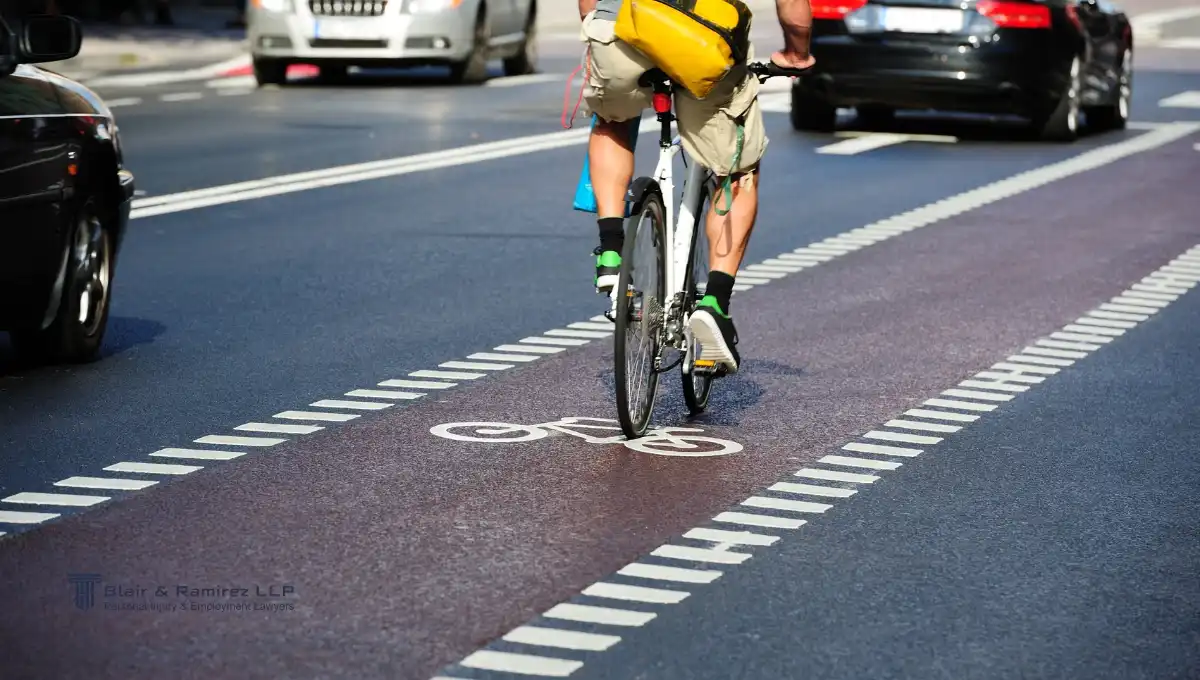
Sidewalk Riding Laws in Los Angeles
In Los Angeles, riding on sidewalks is generally legal unless specifically posted otherwise. However, while it may be allowed, safety should always be a top priority. Riding on sidewalks can be dangerous, especially in busy or crowded pedestrian areas, such as business districts, where the risk of collisions with pedestrians increases. Even though it is legal in many areas, cyclists are encouraged to consider their surroundings and avoid sidewalks in areas with heavy foot traffic to ensure everyone's safety.
Helmet and night visibility laws for riders under 18
In California, there are specific laws designed to protect younger cyclists, especially regarding helmet use and nighttime visibility. These laws are in place to reduce the risk of injury and ensure that young riders are visible to other road users, particularly in low-light conditions.
Required Safety Equipment for Riders Under 18:
- Helmet:
According to California Vehicle Code §21212, all cyclists under 18 years old are required by law to wear a helmet while riding. The helmet must be properly fitted and fastened, covering the head securely. Helmets are one of the most effective ways to reduce the risk of severe head injuries in the event of a crash. - Lights and Reflectors for Night Riding:
When riding at night or in low-light conditions (such as dawn or dusk), cyclists under 18 are also required to have specific visibility gear to ensure they are seen by drivers. The law requires:- A white front light that is visible from at least 300 feet.
- A red rear reflector or a red rear light that is visible from at least 500 feet.
- The combination of lights and reflectors is crucial for increasing visibility and helping cyclists avoid accidents with motor vehicles. Reflectors should be attached to the front and rear of the bike, while a working light must be visible to others from a sufficient distance.
Penalties for Non-Compliance:
Failure to comply with helmet and night visibility laws can result in fines. Cyclists under 18 who are caught without a helmet or proper lighting equipment could face a fine, typically around $25 for the first offense. However, the more significant consequence is the increased risk of injury. Non-compliance makes riders more vulnerable to accidents, especially when visibility is low or they lack the proper protective gear.
Safety Benefits:
- Helmets significantly reduce the likelihood of fatal head injuries in cycling accidents, which is why wearing them is mandated for all minors in California. A properly fitted helmet can protect the brain from serious trauma if a fall or collision occurs.
- Lights and reflectors enhance a rider’s visibility to drivers, reducing the chances of accidents happening due to cyclists not being spotted in time, especially at night. These safety features are especially crucial in urban environments like Los Angeles, where traffic is dense and street lighting can be inconsistent.
What Can Be Done? Infrastructure, Advocacy, and Legal Help
It’s time for action, from the city and from all of us. To create safer streets for cyclists in Los Angeles, we need a combination of better infrastructure, strong advocacy, and legal protections. This includes building more protected bike lanes, enforcing existing traffic laws, and addressing the root causes of accidents. Additionally, cyclists who have been injured or involved in accidents should seek legal help to navigate their rights and pursue justice. In the upcoming sections, we’ll explore the ways infrastructure can be improved, the role of advocacy in making change, and the legal steps to take if something goes wrong.
Enforce Vision Zero
Vision Zero was adopted by Los Angeles in 2015 with the ambitious goal of eliminating all traffic fatalities by 2025. However, recent audits and data indicate that the city is falling short of this objective. In 2024, there were 303 traffic fatalities in Los Angeles, up from 240 in 2015, the year Vision Zero was launched. LAist
Several factors contribute to this shortfall:
- Lack of Coordination: The Vision Zero Steering Committee, intended to coordinate efforts across various city departments, ceased meeting by mid-2018, leading to fragmented implementation of safety measures.
- Insufficient Funding: Between 2015 and 2021, Los Angeles allocated only $138 million to the Vision Zero program, while spending $196 million on injury and death liability claims, indicating a misalignment of priorities.
- Political Challenges: Community resistance and political opposition have delayed or reversed safety improvements in certain areas, undermining the program's effectiveness.
To achieve the Vision Zero goal, it's crucial to address these issues by enhancing interdepartmental collaboration, increasing funding for safety initiatives, and fostering political support for necessary infrastructure changes. Without these concerted efforts, the city risks continuing the upward trend in traffic fatalities.
Help Cyclists Reduce Personal Risk Through Awareness
To reduce personal risk while cycling in Los Angeles, cyclists can take several proactive steps:
- Plan Low-Traffic Routes: Use the LA Bike Map to find quieter, safer routes away from high-traffic areas.
- Wear High-Visibility Gear: At night, wear bright, reflective clothing to ensure you’re visible to drivers.
- Use Front/Rear Lights and Mirrors: Equip your bike with lights for visibility and mirrors to keep an eye on traffic behind you.
- Avoid High-Crash Intersections: Stay clear of intersections with known high collision rates, especially those without adequate bike infrastructure.
By following these tips, cyclists can greatly reduce their risk on LA’s busy streets.
What to Do If You're Injured in a Bicycle Accident
A bicycle crash can be disorienting, painful, and overwhelming. Knowing what to do in the moments and days afterward can protect your health, your legal rights, and your ability to seek compensation if someone else was at fault. Here is a practical, step-by-step guide for what to do immediately after a bicycle accident in LA:
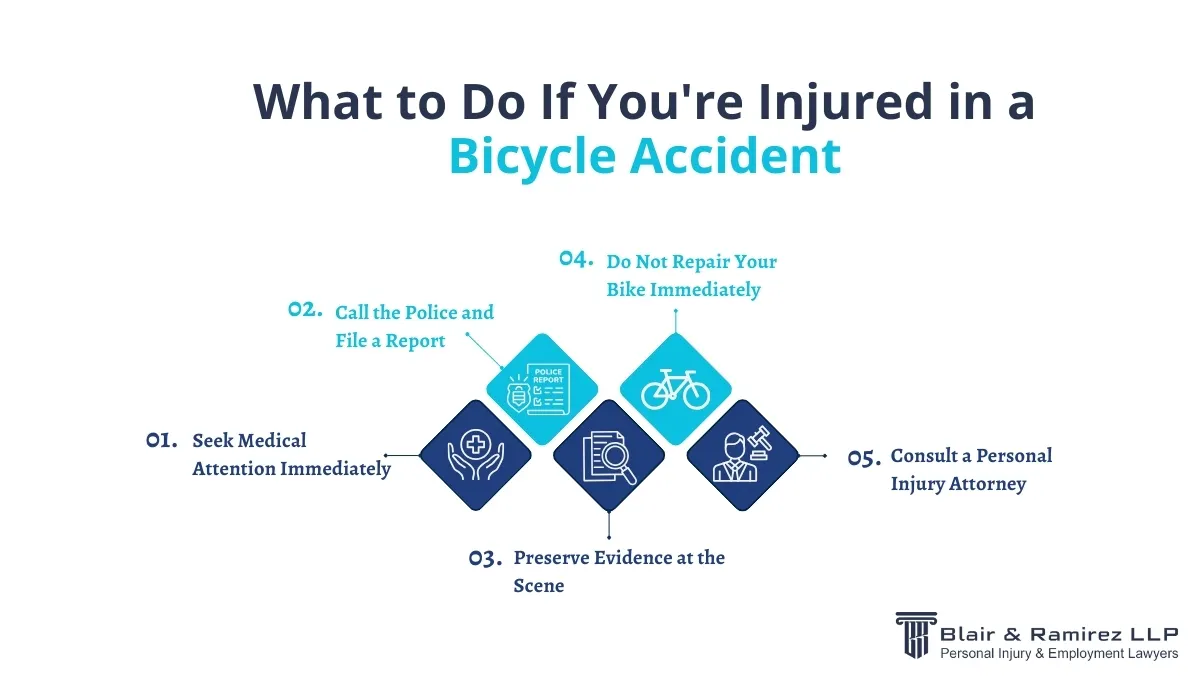
1. Seek Medical Attention Immediately
Even if injuries seem minor, always prioritize your health. Some injuries, like concussions or internal trauma, may not show symptoms right away. Call 911 or visit an emergency room as soon as possible. Medical documentation also serves as crucial evidence if you file a legal claim later.
2. Call the Police and File a Report
You are legally allowed to file a police report after a bicycle accident in California. This creates an official record of the crash, which is essential in any personal injury case. Make sure to describe what happened clearly and request a copy of the report for your records.
3. Preserve Evidence at the Scene
If you are able, take the following actions before leaving the scene:
- Photograph your bike, the vehicle involved, your injuries, the road conditions, and traffic signs.
- Collect contact information from the driver, any witnesses, and their insurance company.
- Do not admit fault or discuss blame—stick to the facts.
If you are too injured to gather this information, ask a bystander or friend to help document the scene.
4. Do Not Repair Your Bike Immediately
Keep your bicycle in the condition it was in after the crash. It may serve as physical evidence in proving how the accident occurred or how severe the impact was.
5. Consult a Personal Injury Attorney
If you were injured due to another party’s negligence, such as a distracted driver, poor road design, or a vehicle violating your right of way, you should contact a personal injury attorney experienced in LA bicycle accidents. An attorney can:
- Protect your rights
- Handle communication with insurance companies
- Help you pursue compensation for medical bills, lost wages, and pain and suffering

Frequently Asked Questions About Bike Safety in LA
Ride Smart, Stay Informed, and Know Your Rights on LA Streets
Los Angeles is home to several high-risk locations where poor infrastructure, high traffic, and unpredictable driver behavior lead to frequent crashes. Understanding the causes, like inadequate bike lanes, aggressive driving, and low visibility, can help you stay safer. As a cyclist, it’s essential to know your legal rights, including laws like the 3-Foot Passing Rule and your right to use bike lanes.
You’re not powerless. With the right knowledge and support, you can ride safer and seek justice if needed. If you or someone you love has been hit while cycling, we’re here to help. Get a free consultation from a bicycle injury lawyer in Los Angeles.


